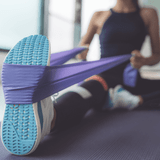A Runner's Guide to Fighting Foot Pain
Key Takeaways
- Foot Pain in Athletes: 25% of athletic injuries involve foot or ankle pain.
- Common Conditions: Common injuries include plantar fasciitis, achilles tendinitis, and stress fractures.
- Management Basics: Preventative measures for foot pain include proper footwear, stretching and strengthening exercises.
- Recovery Techniques: Recovery is essential for repair and strength. Implement active recovery techniques like foam rolling or active recovery products like STAMINAPRO.
As an athlete, you know that foot pain can be a game-changer—literally. Around 25% of sports-related injuries involve the foot and ankle, making it a common issue that can sideline even the most dedicated individuals.
In this blog, we'll break down the complexities of foot pain, from its common causes to effective management techniques. You’ll learn how to prevent injuries, and most importantly, how to use STAMINAPRO to alleviate discomfort and keep you in the game.
Common Conditions Associated with Foot Pain
Foot pain isn't just discomfort; it's a signal from your body that something isn't quite right. For athletes, common culprits include plantar fasciitis, Achilles tendinitis, and stress fractures, which are conditions that often arise from overuse, improper footwear, or insufficient recovery time.
1. Plantar Fasciitis:
- Description: Plantar fasciitis, a common cause of heel pain, is inflammation of the thick tissue band (plantar fascia) connecting your heel bone to your toes.
- Common In: Runners, those wearing shoes with inadequate support, and general overuse.
- Symptoms: Sharp pain in the heel, especially with the first steps in the morning or after sitting for a long time.
2. Achilles Tendinitis:
- Description: This condition involves the inflammation of the Achilles tendon, the large tendon that connects the calf muscles to the heel.
- Common in: Runners who have suddenly increased the intensity or duration of their runs.
- Symptoms: Pain and stiffness along the Achilles tendon, especially in the morning, and severe pain after exercise.
3. Stress Fractures:
- Description: Stress fractures are tiny cracks in a bone, commonly occurring in the bones of the foot due to repetitive force, overuse, or even normal use on a weakened bone.
- Common in: Athletes involved in running sports, activities that involve jumping, & those with weak bones
- Symptoms: Swelling, pain during activity that diminishes during rest, and pain that intensifies over time.
3 Easy Pain Prevention Techniques
To avoid these and other conditions, it's important to practice pain management and proactive recovery techniques.
In terms of long-term management, start with these 3 easy to implement recommendations:
- Check Your Footwear:
Make sure your shoes provide adequate support and cushioning, and replace them when they're worn out to avoid unnecessary stress on your feet and ankles. - Incorporate Strengthening Exercises:
Focus on exercises that strengthen the muscles and ligaments in your feet and ankles, such as toe curls, calf raises, and ankle circles. These exercises help improve stability and reduce the risk of injuries. - Gear Your Workouts Around a Rest Period:
Integrate rest days into your training schedule to allow your feet and body to recover properly. Overtraining can lead to fatigue and increased risk of injuries, so listen to your body and prioritize rest as part of your workout routine.
For immediate pain, remember RICE: Rest, Ice, Compression, and Elevation.
Rest: Avoid using the injured area to prevent further damage and to promote healing.
Ice: Apply ice or a cold pack to the injured area to reduce swelling and numb pain. Do this for 15-20 minutes every hour for the first 48 hours.
Compression: Use an elastic bandage to compress the injured area, which helps to minimize swelling. Ensure it's snug but not too tight to avoid cutting off circulation.
Elevation: Elevate the injured area above the level of the heart to reduce swelling and promote drainage of fluids.
The Importance of Proactive Recovery
Recovery isn't just about taking a break; it's an active process. Here's how to make the most of it:
- Hydration and Nutrition:
Replenish electrolytes and consume a balanced diet rich in nutrients to promote muscle repair and reduce inflammation. - Rest and Sleep:
Aim for 7-9 hours of uninterrupted sleep each night to allow your body to repair and regenerate tissues, hormones, and energy levels. - Active Recovery Exercises:
Engage in low-intensity activities like walking, swimming, or yoga to increase blood flow, reduce muscle stiffness, and promote recovery without causing additional stress on your body. - STAMINAPRO Recovery Patches:
Incorporate STAMINAPRO patches into your recovery routine to target specific areas of discomfort and support your body's natural healing process. Unlike many pain relief options that rely on medications, our patches use a drug, chemical, and medication-free formula, ensuring they're safe to use for runners of all ages and competitive levels.
Ready to Step Up Your Game?
Explore more about STAMINAPRO patches and join our community of athletes who've found relief and enhanced performance.







